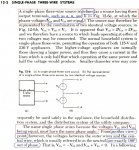weressl
Esteemed Member
Anode and cathode on scope leads....think you lost the plot there.
If you want to measure the the two voltages to neutral on a centre tapped transformer you need a dual trace oscilloscope. You would have have a common point to which you would connect ONE of the grounded leads. And measure and display both with respect to that.
Neither is reversed.
Well, sort of. It is one continous winding, that is tapped at midpoint, installed over a single core. So the flux induces voltage that will cause the current to flow in the same physical direction in both segments of the coil. Grounding the center tap will establish the common reference point in relation to ground potential at the center tap. Ground potential is commonly referenced to and taken as 0 voltage. If one is to connect a dual trace scope that the base potential of each trace - the reference point - is both connected to the grounded center tap and the measuring probe one is connected to L1 and the other is to L2, then we will see the two potentials 180 degrees apart, each having close to equal peaks at 90 and 270 degrees and 0 crossing at 0 and 180 degrees.
Should one is to connect the probes of an ISOLATED input scope and connect it in the following fashion: L1 to base(1) and N to measuring probe(1), then N to base(2) and L2 to measuring probe(2), one would see two nearly overlapping traces for each phase that would peak and fall nearly identically. (I am using 'nearly' as to allow for manufacturing tolerances, possibly resulting in fractions of a volt differences between the two segments of the winding.) Of course if we have a third probe and we were to connect that base(3) to L1 and measuring probe(3) would receive L2, we sould see a trace that is IN PHASE with the above traces, but twice the amplitude.


